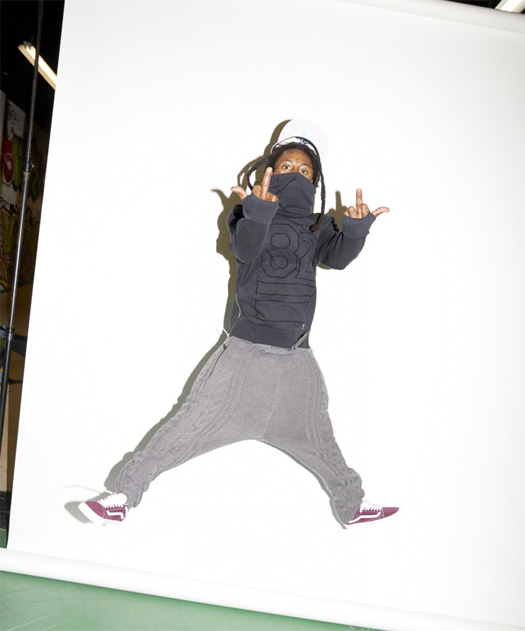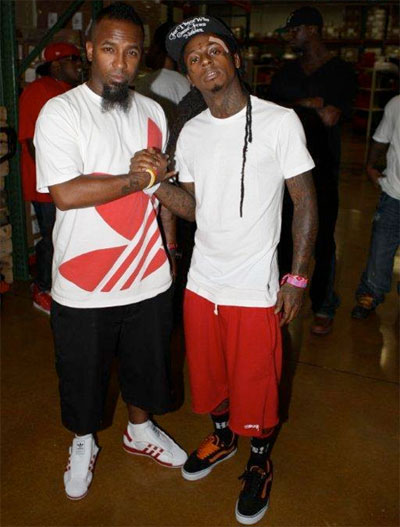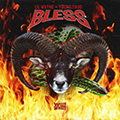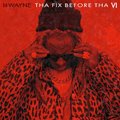
Last month, we saw the cover of NYLON Guys magazine’s December 2014/January 2015 issue that featured Lil Wayne on the front, as well as some excerpts from Wayne‘s interview.
Now we can read the full cover story that includes a detailed description of what Tunechi has in his house, as well as hear what Tune‘s recording process is like, him going to jail, needing weed, suffering from seizures, skateboarding, living and breathing music, and more.
You can check out the conversation after the jump below. This issue of NYLON Guys magazine is also available on newsstands now, so be sure to pick it up if you haven’t done so already!
If you somehow find yourself at the gates of Lil Wayne’s fortified Miami Beach palace, a security guard will interrogate you as soon as your car door slams shut. He’ll require that you state your business, and even if said business checks out, you’ll be zealously scrutinized as though you’re trespassing on an arsenal of nuclear warheads. The 15,000-square-foot, $11 million, hyper-modern waterfront compound nests on a banana-palm-ringed island. Wayne’s publicist prefers that the exact location be kept secret, and for good reason. Over the past decade and a half, the 32-year-old from the impoverished Hollygrove section of New Orleans has been worshipped at levels usually reserved for European soccer gods, martyred icons, and Marvel superheroes.
During an age when celebrities flash their day-to-day indecencies to reveal that they’re “just like us,” Wayne is the extraterrestrial inverse. It’s almost more difficult to envision him as a corporeal breathing and belching mortal than as a rap game Roald Dahl character. His self-descriptions burnish the image. He’s a beast, a dog, a Martian, a vampire, a goblin.
Two separate volumes in his catalogue are entitled I Am Not a Human Being.
But you can confirm that Lil Wayne (né Dwayne Michael Carter, Jr.) is legitimately flesh and blood if you successfully negotiate security. Closer to the compound, one can spot a butler offering hors d’oeuvres just beyond the Tetris-like facade of tilted glass rectangles. If you furnish his minions with the magic password, a metallic drawbridge gate will rise. This is your cue to enter.
A certain hallucinogenic expectation comes with the territory. Wayne’s principal residence should theoretically glow with the phosphorescence of a Chocolate Factory or Playboy Mansion. But no codeine syrup waterfalls, exotic harems, or pet tigers exist here. Just a koi pond. The butler isn’t real either. It’s just a statue, frozen in service by the front window.
It’s past 10 p.m. on a balmy Thursday in early November. Roughly a month from now Wayne will release Tha Carter V, one of the year’s most thirstily anticipated albums, rumored to include guest appearances by Drake, Kendrick Lamar, and, inevitably, most of your other favorite rap stars. This interview is intended for its promotion, but by most forms of accounting, Wayne is roughly 350 hours late.
Our meeting was originally supposed to occur in Los Angeles, where Wayne lived for much of the first half of 2014 before embarking on a tour with Drake—one of the two marquee artists on his Young Money Entertainment label (Nicki Minaj being the other). At some point, Wayne decided that he didn’t want to leave Miami after all. Hence, he’s somewhere in this maze, asleep, recording, or levitating atop a skateboard smoking the world’s most rarified strain of kush.
Even if you breach the fortress of solitude, expect to wait before being received by the emperor. A 2 p.m. start time becomes 10 p.m., becomes whenever Wayne rousts himself from an evening nap. Upon awakening, a headache might strike. So you’ll probably kill time in the living room. And unless you’ve appeared on an episode of MTV Cribs or use “summer” as a verb, it’s unlikely that you’ve been inside one like Lil Wayne’s.
Light from a full moon seeps through a grid of glass windowpanes. The color scheme is Acropolis gray. It feels more like a pimp’s lunar shrine than a lived-in home. Basquiat paintings and Andy Warhol “Marilyn” silk screens adorn the walls. A baby grand piano hulks beneath 50-foot ceilings. Multiple guitars slouch beside art and mythology books, a telescope, framed photos of Jimi Hendrix, B.B. King, Bob Marley, Wayne’s children, and artsy pin-up girl collages. There are several portraits of Weezy F. Baby— including one where he’s the aquatic infant from Nirvana’s Nevermind cover. Skate magazines rest atop copies of Robb Report.
The platinum plaques on the entry walls remind you why millions regard him as the greatest of his generation. He’s sold over 15 million records, eclipsing Elvis Presley as the male artist with the most entries on the Billboard Hot 100. A dedicated shelf displays his Grammys for Best Rap Album (The Carter III), Best Rap Solo Performance (“A Milli”), and Best Rap Song (“Lollipop”). These cohabitate with MTV awards, World Music awards, Billboard awards—the list continues.
“I was always ready for the call. That’s the best way to explain it. Wayne’s always ready,” says Wayne later that night. “When it’s my turn, I make way more than the most of it. If you’re ready when they call you, and you make the most of your time, then they’ll never stop calling you.” If a personal philosophy explains Wayne’s longevity and seismic career swings, this might be it. The same idea applies to being granted an audience with him. You don’t sell a million copies in the first week (as he did on 2008’s Tha Carter III) without being cognizant of your abilities to captivate or intimidate. Ask a stupid question and he’s apt to stonewall or dismiss you. Approach from a latitude of respect and understanding and he’ll open up sincerely. But you better be ready.
When the call comes, it’s almost midnight. Wayne wants to talk in a wing only accessible by returning outside to walk past a panther-black Maybach Landaulet (price tag: $2.5 million). He waits inside the sort of fantasy cave that you might’ve dreamed up at 15 years old—the age when Wayne joined Cash Money’s The Hot Boys and went platinum while still in high school.
Graffiti scrawls and blocky cartoon characters decorate the walls. A line of Lego men is neatly assembled on a ledge. There’s the requisite Pac-Man machine. In a small kitchen, a chef cooks a midnight dinner of spaghetti and meatballs and corn. Finally, there’s Wayne, groggily reclining on a couch in maroon mesh shorts and a black Trukfit tee (his clothing line), sitting underneath a frieze of 100 skateboards of varying fluorescent colors and models.
There’s a stark contrast between Wayne’s current sluggishness and his feral-gremlin-after-dark stage voltage. If you didn’t know any better, you might’ve guessed that he hadn’t peeled himself off the couch in weeks. His dreadlocks splay like the rabbit ears of a television antenna. His bleary eyes squint with half-interest at the NBA basketball game on the television. Every square inch of skin is covered in tattoos. With a drowsy grunt, he eventually acknowledges that someone has entered. Barely glancing up, he offers his knuckles for a pound, and sparks a blunt.
“I never want to say this word, but it’s easy for me right now,” admits Wayne, exhaling smoke and taking a birdlike bite of pasta. His voice is low and muddled, like cleats stabbing gravel. “And it’s so easy that it’s complicated.”
This is his headspace leading up to the release of Tha Carter V. As one of the most improvisational rappers of all time, Wayne is notoriously loath to articulate what often comes effortlessly. “I’m just a regular street nigga that’s a little smarter than the rest. I rap whatever comes up in my head,” he adds. “Whatever rhymes with the next word and how I’m feeling. I start rapping and we find something within what I just said and make a song out of it.” His words recall the John Keats quote: “If poetry comes not as naturally as the leaves to a tree, it had better not come at all.” But Keats relied on the quill and tablet and Wayne insists that he never writes.
It’s been that way since 2004, when he molded the nimble bayou bounce of his early style to a fanged and intricate attack indebted to traditional East Coast slickness. While other rappers were seeking risk-free replications of gangster archetypes, Wayne got weirder and weirder, using Prince, syrup, sex, and weed as divine muses. “When he raps, he makes you think,” says Minaj, the first female artist Wayne signed to his Young Money imprint. “His wordplay, skill, intelligence, metaphors, cartoonish flows, and voices are unmatched. He taught me the true meaning of work ethic. Even when you’re the boss, work like it’s your first day on the job.”
Cranking out surrealistic pun-and-simile jags, Wayne forged his legend by demolishing every hot single, dropping countless mixtapes, and proclaiming himself “The Best Rapper Alive.” By the release of Tha Carter III, the arrogance felt prophetic. And then he went to jail. “I went in there at 138 pounds and came out 152. That was the only change I knew in there,” says Wayne with a chuckle when asked about the long-term impact of the eight months of 2010 that he spent on Rikers Island for “attempted criminal possession of a weapon.”
But incarceration altered a few things. What once came off as inspired mania sometimes started to feel erratic and out of focus. A generation of artists raised on Wayne emerged, making his stylistic innovations part of their portfolio. He made a rap-rock album. Probationary drug tests also made marathon weed-smoking sessions impossible. Call it tangential, but a sober Wayne is as unthinkable as a teetotaling Bob Marley, Willie Nelson, or Snoop Dogg. His music often missed that narcotic elasticity. “I don’t know how it works, but I know that I need weed…extra when I’m creating,” says Wayne, becoming more alive and affable with every hit, as though the THC is laced with caffeine. Two more blunts wait in an orange airtight canister. A half-dozen are half-smoked in the ashtray—each a belated celebration over the drug testing that ended a year ago. “It helps in a major way.”
Other contraband has a less dependable track record. In October of 2012, a pair of seizures forced Wayne into the hospital. Another set struck in March of the following year. The details are murky, but the situation was so severe that TMZ reported and then retracted the claim that Wayne received his last rites. The tabloid news site alleged that doctors found dangerously high levels of codeine in his system. Wayne countered by admitting that he suffered from epilepsy, which had stricken him many times in the past.
“I wasn’t aware of anything. It just happened and I woke up in the hospital. I don’t remember anything about the experience,” says Wayne with a shrug. “It might have been the reality. It might have felt like it in the news, but for me, I was just the guy in the hospital chilling.” If anything, the outpouring of support from other celebrities surprised him the most. He expected concern from fans and family, but received heartfelt convalescent visits from Drake, Minaj, Usher, and Los Angeles Clippers star Chris Paul. “I don’t mean to sound bad, but it wasn’t no life-changing thing,” continues Wayne, momentarily slipping into memories he’d rather not dredge. “I shot myself when I was 12. I grew up in Hollygrove. I’ve seen way worse.” When you’re blessed with obscene talent, obsession, and millions of dollars at an early age, the logical outcome is to push your invincibility to the brink. Music history is a relief map of premature death. Those who survive usually turn to religion or doting parenthood; Wayne found skateboarding. He discovered it a few years ago while watching a Fuse show about a skateboarding prodigy named Alex Midler. They’ve since become close friends. “His spirit was so awesome that he made a motherfucking nigga from the streets pick up a skateboard and fall in love with it,” says Wayne.
In a couple of hours, Wayne and friends will sneak into a local elementary school to practice “pop shuvits” and “fakies” on its stairwells. They’ll have until 6 a.m., when the principal arrives. “Hopefully, I’ll land them. If not, I’ll kill myself trying,” he says. It’s not idle bravado. Wayne showed up to the photo shoot for this story with a black eye from an unforgiving skate ramp. “SASARAF” is how he summarizes his day-to-day life in 2014. “Smoke and skate and rap and fuck.”
The joy from his newfound hobby has seemingly spilled over into his old calling. His new songs sound as deliriously locked-in as anything since his great psychedelic run. “Once he moved to L.A., he got into a zone that he hadn’t been in in years. Ever since then, he’s been at it every single day,” says Cortez Bryant, Wayne’s longtime manager, A&R guru, and Chief Visionary Officer of Young Money. “I think he’s in a phase where he’s out to show people that he’s still the best.”
Wayne would be the first to agree. His monomaniacal drive to be the best brings to mind his friend, Kobe Bryant, who first Twitter-leaked the news that “Carter V Season” was approaching. As for the latest installment of his series, Wayne says that he’s rolled his stylistic experimentations into one, rather than compartmentalizing songs for specific audiences. He’s also been possessed by a sudden perfectionist streak, part of an effort to make his raps easier to comprehend. “I never gave a fuck about that shit before,” rasps Wayne. “I was always like, ‘You’re from the South, this is your drawl, and if they don’t understand your lyrics, then they just don’t get it.’ I’m not simplifying things because I never simplify shit, but I do want to be understood.”
The specter of retirement lingers in nearly every interview. He insists that he’s serious about it without the tacit wink that accompanies most musicians’ idle threats. Tha Carter V was originally touted as his last solo album, a claim he’s since rescinded. He refuses to give a concrete date for his departure, but implies that it’s sooner rather than later.
Even if you are Lil Wayne, there is only so long that you can be Lil Wayne.
As he incinerates blunt after blunt, you sense his creeping discontent with the industry. He initially wanted to package Tha Carter V as a double CD, but big-box retailers threatened to refuse to carry it, wary of $20-plus records in an evaporating market. There is also a generation gap.
“When I first started doing it, you only did it to be the best— not to have a hot song or popularity or for Instagram or Twitter,” says Wayne, sighing. “I’m one of the last of a dying breed…the ones who are only about the music. You have to want to be unforgettable. The only other people who I can think of like that are Kanye and Beyoncé.” He qualifies his statement by admitting that he doesn’t know for certain. It’s just his impression. But give or take a few more, the assessment isn’t far off. There will always be gifted original artists, but you can’t mint another Lil Wayne, let alone market-research one into existence. “What I mean by that is that all I am is music. That’s all I do and all I know, 366 days a year, 25 hours a day, eight days a week,” says Wayne, snuffing out one more blunt, his gestures suddenly turning slightly weary and ancient, somewhere else again. A beast, a dog, a Martian, a goblin, an island. “This is my life and what I breathe,” he says. “This isn’t something I do. It’s who I am.
Via NYLON Guys





